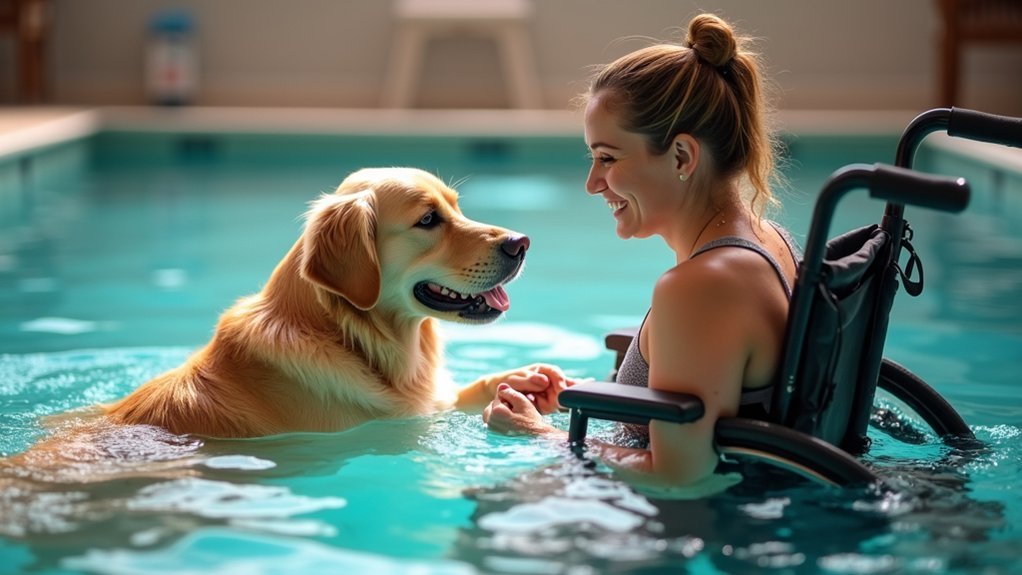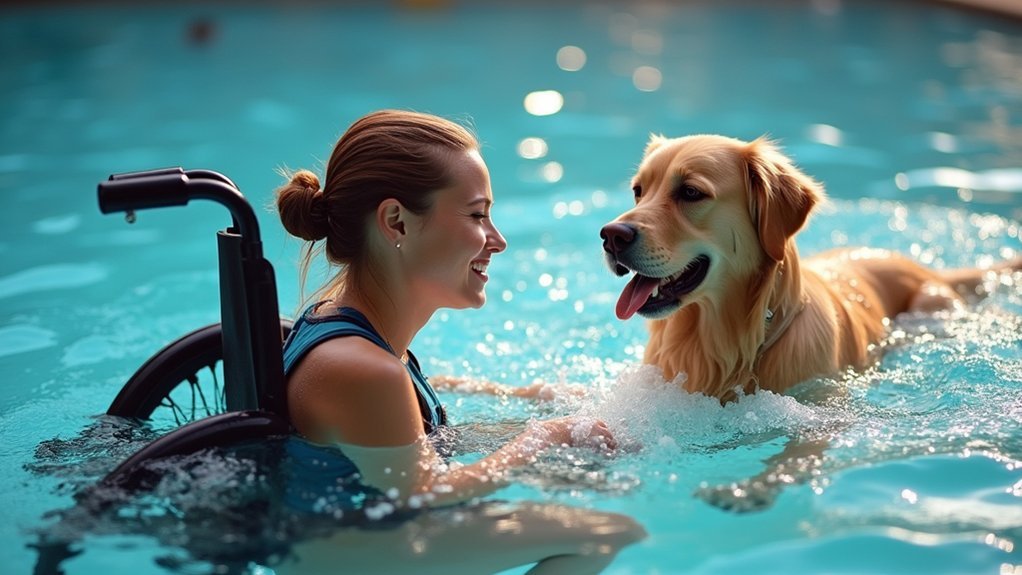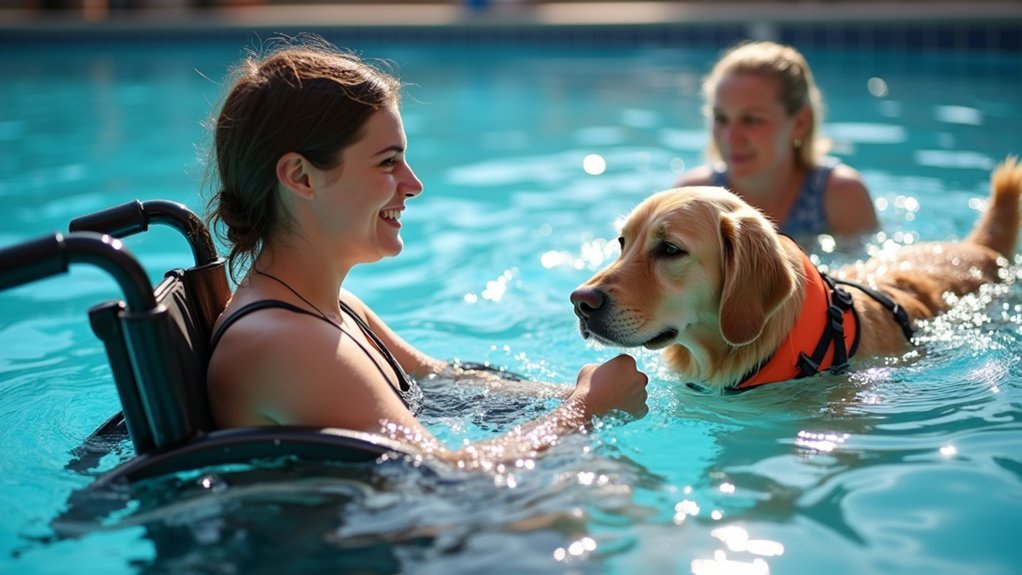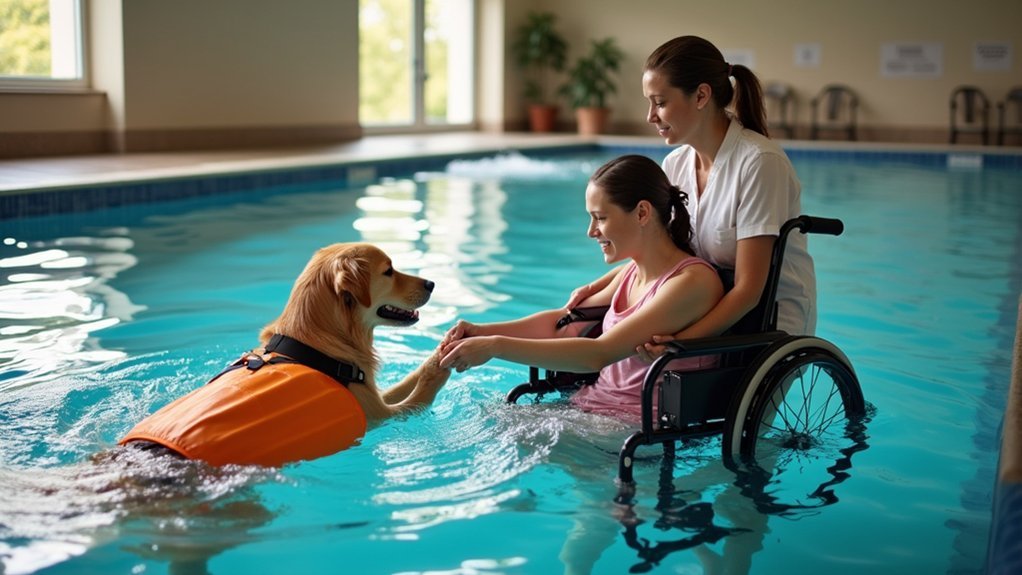Animals enhance aquatic therapy for disabled individuals by reducing anxiety and transforming challenging exercises into engaging activities. You’ll experience decreased pain perception and improved muscle relaxation as animals provide emotional support during rehabilitation. Their presence creates positive distractions from discomfort while promoting social connections and communication skills. Therapy animals also help build confidence that extends beyond the pool into daily life. Discover how these healing connections can transform isolation into meaningful engagement throughout your recovery journey.
The Role of Animals in Enhancing Aquatic Therapy Experiences

When it comes to enhancing aquatic therapy experiences, animals play a surprisingly notable role that extends far beyond mere companionship.
You’ll find that therapy animals can considerably reduce your stress and anxiety during sessions, creating a calmer environment for rehabilitation.
Animals provide powerful motivation boosts when you’re facing challenging exercises. Their presence encourages you to participate more fully and stay engaged with your therapy program.
The simple presence of an animal companion transforms difficult rehabilitation exercises into engaging, purposeful activities you’re more likely to complete.
For disabled individuals, specially trained service dogs offer emotional support during potentially uncomfortable or painful rehabilitation sessions. The warm water environment particularly helps with pain relief and muscle relaxation while animals provide comfort during therapy.
In therapeutic settings, these animals facilitate meaningful interactions that improve your overall experience.
You’ll also benefit from the social connections formed through animal-assisted therapy, as they help bridge communication gaps and create shared positive experiences with other participants and therapists.
Physical Benefits of Animal-Assisted Aquatic Rehabilitation
The physical benefits of animal-assisted aquatic rehabilitation extend far beyond traditional therapy approaches. When you interact with animals during water therapy, your muscles naturally relax, reducing tension that might otherwise limit your progress.
This unique combination creates an environment where you’ll likely experience decreased pain perception during challenging exercises.
Water’s natural buoyancy already supports your body, but adding animal interaction enhances your mobility and encourages more fluid movement. You’ll find yourself reaching, stretching, and engaging in ways that improve flexibility and range of motion.
The resistance provided by water strengthens your muscles without straining joints, while the sensory stimulation from animal contact improves integration and coordination.
These elements combine to create more effective rehabilitation outcomes through your increased engagement and motivation to participate.
Emotional and Psychological Support From Animal Companions in Water Settings

Animals offer profound emotional and psychological support during aquatic therapy sessions, creating a unique therapeutic environment that goes beyond physical rehabilitation. You’ll experience reduced anxiety and stress when working with animal companions in water, as they naturally release oxytocin—your body’s comfort hormone. Observing the rhythmic movements of aquatic animals can help quiet racing thoughts and induce a sense of relaxation and mindfulness.
| Emotional Benefit | How Animals Help |
|---|---|
| Reduced Anxiety | Animals provide calming presence during challenging therapy exercises |
| Increased Motivation | The novelty of animal interaction boosts your engagement and commitment |
| Enhanced Trust | Animal companions foster confidence in the water environment |
The therapeutic bond you’ll develop with these animals can greatly improve your mental health outcomes. This connection often distracts from discomfort during therapy, creating a positive experience that encourages you to continue treatment and achieve better long-term results.
Creating Effective Animal-Integrated Hydrotherapy Programs
Creating effective animal-integrated hydrotherapy programs requires a thorough approach that balances the needs of participants with carefully selected animal companions.
You’ll need to develop extensive frameworks that guarantee both therapeutic benefits and safety for everyone involved.
Key elements for successful implementation include:
- Adopting a collaborative multidisciplinary approach with physiotherapists, veterinarians, and animal trainers working together
- Designing customizable therapy plans that adapt to individual needs while maintaining rigorous safety protocols
- Carefully matching animals with clients based on temperament compatibility and specific therapeutic goals
- Implementing regular progress monitoring to adjust interventions as participants advance
- Establishing clear certification standards for both human practitioners and animal handlers
These foundational components create sustainable programs where the therapeutic relationship between humans, animals, and water can flourish, maximizing rehabilitation outcomes for disabled participants. The integration of horses in aquatic settings can significantly enhance physical outcomes by providing unique opportunities for balance and coordination improvement during water-based exercises.
Success Stories: Transformative Journeys of Disabled Individuals With Animal Support

You’ll find inspiration in the remarkable stories of disabled individuals who’ve achieved mobility breakthroughs with animal companions by their side during aquatic therapy.
These partnerships often facilitate trauma recovery as animals provide both emotional support and physical motivation during challenging rehabilitation exercises. Hydrotherapy creates an ideal environment for healing as the decreased body weight in water significantly relieves pressure on injured joints.
The confidence gained through animal-assisted hydrotherapy extends well beyond the pool, transforming daily lives and fostering independence in ways traditional therapy alone couldn’t achieve.
Mobility Breakthroughs Through Companionship
While many rehabilitation strategies focus solely on physical techniques, the transformative power of animal companions in aquatic therapy has produced remarkable mobility breakthroughs for disabled individuals.
When you combine water’s buoyancy with animal motivation, you’ll find a unique rehabilitation environment that creates exceptional results.
The combination delivers impressive mobility improvements through:
- Enhanced confidence during aquatic exercises, allowing you to attempt more challenging movements
- Increased therapy compliance with dropout rates considerably lower than conventional treatments
- Greater range of motion achievements supported by the emotional connection to therapy animals
- Reduced anxiety and stress during rehabilitation sessions, enabling deeper focus on physical goals
- Improved social interaction creating a positive feedback loop that reinforces mobility gains
Research shows that animal-assisted psychotherapy has a significantly lower dropout rate of just 11.2% compared to conventional psychotherapy approaches.
Trauma Recovery With Animals
When traumatic experiences leave individuals feeling isolated and disconnected, animal-assisted aquatic therapy often creates profound healing opportunities not available through traditional methods alone.
You’ll find that therapy animals reduce stress hormones while simultaneously improving your mood during water-based sessions. These specially trained companions help ground you in the present moment, countering trauma’s tendency to disconnect you from your surroundings.
The combination of water therapy and animal support creates a uniquely safe environment where you can process trauma without feeling judged. Whether working with therapy dogs poolside or engaging in equine-assisted aquatic programs, these interventions have shown remarkable success in reducing PTSD symptoms and problem behaviors. Research has demonstrated that Animal Assisted Therapy provides significant benefits as a nonpharmacological treatment option for various mental health disorders.
You’re never alone in your recovery journey—therapy animals serve as consistent allies, helping you navigate challenges while fostering healing connections that transform isolation into meaningful engagement.
Confidence Beyond The Pool
The transformative power of animal-assisted aquatic therapy extends far beyond the confines of the therapeutic pool, creating lasting confidence that permeates every aspect of participants’ lives.
You’ll discover that skills developed with animal support naturally transfer to daily challenges.
- Confidence gained in water environments naturally extends to social situations, education, and family life
- Working with animals helps you overcome fears, building resilience that applies to new challenges
- Adaptive skills developed during therapy sessions become valuable tools for independent living
- Successful aquatic therapy experiences make community integration less intimidating
- The psychological benefits of bonding with therapy animals continue long after sessions end
This confidence transformation is perhaps the most significant outcome, empowering you to pursue opportunities that once seemed impossible. Much like Army Staff Sergeant Casey Church who recovered through pool therapy when land-based activities were not possible, animal-assisted aquatic therapy provides unique rehabilitation options for those with limited mobility.
Specialized Equipment and Environments for Animal-Assisted Aquatic Therapy

You’ll find that specially designed aquatic therapy spaces incorporate safety features like non-slip surfaces and controlled water temperatures to protect both disabled participants and therapy animals.
Adaptive water equipment, including underwater treadmills, harnesses, and mobility aids, allows for customized therapy sessions that meet your specific rehabilitation needs.
Multi-sensory hydrotherapy environments can further enhance your therapeutic experience by combining visual, tactile, and auditory elements that engage both you and your animal companion.
Equipment like the HydroWorx K900 offers adjustable water depth from 1″ to 24″ to accommodate different therapy animals while ensuring comfort for participants with disabilities.
Safe Aquatic Therapy Spaces
Creating safe, specialized environments remains essential for effective animal-assisted aquatic therapy to flourish. These therapeutic spaces are thoughtfully designed with both human and animal needs in mind, ensuring comfortable and productive sessions.
Key safety features include:
- Shallow entry areas with gradual inclines for easy access by animals and disabled participants
- Closed-loop filtration systems that maintain ideal water quality and temperature
- Access ramps and specialized lifts accommodating animals and humans with mobility challenges
- Monitoring systems tracking water conditions and ensuring chemical balance
- Trained therapy staff present to supervise interactions and provide immediate assistance
The therapy helps participants manage chronic pain conditions while reducing gravitational forces on their bodies. You’ll find these specialized environments incorporate state-of-the-art equipment like underwater treadmills and resistance pools, creating extensive therapeutic settings where both animals and humans can heal together safely.
Adaptive Water Equipment
Specialized equipment plays a pivotal role in animal-assisted aquatic therapy, enabling therapeutic environments where animals and humans can work together for maximum benefit.
You’ll find underwater treadmills with variable speeds that allow for customized rehabilitation while maintaining proper gait patterns in a buoyant environment.
For facilities incorporating therapy animals, non-slip flooring is essential to prevent accidents, while customized access ramps help animals enter and exit safely. The warm water temperature provides pain relief and muscle relaxation for both the therapy animals and disabled individuals during sessions. Dedicated resting areas guarantee animal welfare during sessions.
When combining traditional aquatic therapy tools with animal assistance, you’ll need specialized safety gear and adapted resistance devices.
Though standardized aquatic animal-assisted therapy remains limited, innovative equipment adaptations are emerging to safely integrate animals into therapeutic pools, providing unique benefits for disabled individuals while maintaining ethical considerations for all participants.
Multi-Sensory Hydrotherapy Environments
Multi-sensory hydrotherapy environments combine controlled aquatic settings with animal-assisted therapy to create powerful therapeutic experiences for disabled individuals.
These specialized pools engage multiple senses simultaneously, enhancing therapeutic outcomes through carefully designed features. The combination of buoyant force and animal interaction creates an ideal environment for rehabilitation exercises with reduced joint stress.
- Controlled water temperature and lighting optimize comfort and sensory engagement while animals provide tactile stimulation.
- Underwater speakers and colored lighting systems create calming auditory and visual stimuli that improve focus.
- Varied pool depths encourage different movements and positions, enhancing vestibular input and spatial awareness.
- Animals create additional proprioceptive feedback through water displacement and movement patterns.
- The combination of animal presence and water’s natural properties reduces anxiety, creating a safe space for therapeutic progress.
You’ll find these environments specifically engineered to maximize sensory integration while supporting the unique connection between clients, therapy animals, and water.
Frequently Asked Questions
What Training Do Therapy Animals Need for Aquatic Environments?
For aquatic environments, your therapy animal needs specialized aquatic training, gradual water exposure, safety protocol knowledge, hands-on practice, and ongoing training. They’ll also need certification from reputable organizations and excellent adaptability skills.
Are There Insurance Considerations for Animal-Assisted Aquatic Therapy?
You’ll need to verify both your insurance and the provider’s policy cover animal-assisted aquatic therapy. Many plans require documentation of medical necessity, licensed providers, and specific credentials for therapy animals.
How Does Chlorine Affect Therapy Animals’ Health?
Chlorine can irritate your therapy animal’s skin, eyes, and respiratory system if levels aren’t properly monitored. You’ll need to rinse them thoroughly after sessions and watch for ear infections or skin dryness.
Which Animals Besides Dogs Work Best in Aquatic Therapy?
Besides dogs, you’ll find miniature horses work exceptionally well in aquatic therapy due to their calm temperament. Pigs, llamas, and alpacas can also adapt effectively to water-based rehabilitation when properly trained with specialized equipment.
What Safety Protocols Protect Both Patients and Animals?
You’ll find thorough safety protocols that include regular equipment inspections, proper animal training, maintaining water quality, ensuring slip-resistant surfaces, and establishing emergency procedures. These protect both you and your therapy animals during sessions.
In Summary
You’ve seen how animal companions transform aquatic therapy for disabled individuals. They’re not just support animals; they’re healing partners that enhance physical recovery while providing emotional stability. Whether you’re working with dolphins, therapy dogs, or other trained creatures, you’ll find that integrating animals into water-based rehabilitation creates powerful healing connections. When you combine water’s therapeutic properties with an animal’s intuitive support, you reveal remarkable potential for growth and independence.





Leave a Reply